Abstract
Sinter has been introduced into the composite burden of the COREX ironmaking process in China to lower the material cost, but the proportion is limited due to its poor low-temperature reduction degradation performance in the shaft furnace. This work dealt with the preparation of sinter for the COREX process by varying the MgO content and basicity. Their effects on the sintering and reduction properties under reducing condition simulating COREX shaft furnace were investigated, and the changes in the mineralogy of sinter with different MgO content and basicity were explored. The results showed that increasing MgO content affected the sinter strength and solid fuel consumption but restrained reduction degradation of sinter in the shaft furnace. In the basicity range of 0.8–2.6, the strength, RDI+6.3 and RDI+3.15 of sinter all presented a V-shaped curve and the minimum value occurred at a basicity of approximately 1.6. By comprehensive consideration, sinter with 2.35%+ MgO and 2.2+ basicity for COREX process was proposed and verified in industrial tests. Sinter with higher MgO content contained less SFCA and hematite, while glass and SFCA were dominant in the binding phase in sinter with low basicity (0.8) and high basicity (2.6) respectively and were associated with the relatively higher sinter strength. The changes in the mineralogy of sinter determined the variations of RDI of sinter with different MgO content and basicity, by affecting the sinter strength and the probable reduction of inner stress.
1. Introduction
As a typical non-blast furnace ironmaking process, the COREX reduction process relies less on high-quality coke than the traditional blast furnace ironmaking process [1,2,3]. Two sets of COREX devices were introduced and built at the Baosteel Luojing steel plant in China in 2007 and 2011 [4]. After running for several years, both COREX devices were shut down successively due to the higher fuel consumption and raw material cost than the design parameters [5,6]. In 2013, the COREX devices were dismantled and moved to BayiSteel in Xinjiang Province with the expectation of reducing production costs by taking advantage of the abundant coal resources and local pellet whose prices are 80% and 30% lower respectively. Considering the surplus capacity and lower cost compared to pellet, the sinter was innovatively introduced into the burden of the COREX process when it was put into production again in 2015 [7]. However, with the increase of sinter proportion in the composite burden, exceptions of gas distribution and even hanging occurred in the shaft furnace. Then the sinter proportion was limited to under 25% [8,9]. In view of the influence of the burden profile on the gas–solid distribution in the COREX shaft furnace, the abnormal phenomena were attributed to the worse low-temperature reduction degradation of sinter compared to pellet [10,11]. This speculation has been confirmed in another study, which showed that increasing the sinter proportion has an obvious adverse effect on the reduction degradation index (RDI+6.3 and RDI+3.15) of the composite burden in the COREX shaft furnace. Meanwhile, a requirement for the low-temperature reduction degradation performance of composite burden was proposed as RDI+6.3 ≥ 70% and RDI+3.15 ≥ 80% when sinter was used for COREX process production. Given this premise, the RDI+6.3 and RDI+3.15 of sinter should reach above 50% and 70% respectively, if the sinter proportion rose to 40% in the composite burden [12]. Consequently, improving the low-temperature reduction degradation performance of sinter in the shaft furnace became a critical issue for increasing the sinter proportion in the composite burden and further reducing the material cost of the COREX process.
Earlier studies were conducted aimed at the reduction degradation phenomena of sinter in the middle-upper part of the blast furnace [13,14,15]. In the reductive zone of 450–600 °C, the Fe2O3 crystal in sinter transformed into Fe3O4 and generated volumetric expansion and inner stress. As the strength of sinter could not resist that inner stress the degradation of sinter occurred. According to relative studies conducted under conditions simulating the reducing process in the blast furnace, various factors such as sinter basicity (CaO/SiO2), chemical compositions and mineral phases can influence the reduction degradation of sinter [16,17]. Furthermore, with the presence of H2 in reducing gas, the degradation of sinter seems more serious and faster [12,18]. Considering that the reducing gas in the COREX shaft furnace contains 15–23% H2, which is markedly different from that in the blast furnace, the effect of different factors on the production and reduction properties of sinter deserves more attention and research work from the perspective of preparing a qualified and cost-effective burden for the COREX process.
This work studied the preparation of sinter for the COREX process by varying the MgO content and basicity of sinter, and their effects on the sintering and metallurgical performance of sinter in the shaft furnace, including low-temperature reduction degradation and reduction performance, were investigated respectively under simulated reducing conditions. Then, the optimal parameter combinations of sinter basicity and MgO content were proposed for preparing qualified sinter for the COREX process. Simultaneously, the changes in the mineralogy of sinter with different basicity and MgO contents were explored, and their relations with the quality and reduction properties of sinter were discussed. Finally, industrial tests were carried out for validation.
2. Materials and Methods
2.1. Materials
Materials including blending ore, fluxes and fuels used in the present work were all supplied by a local sintering plant. The blending ore consisted of several kinds of magnetite concentrate, pellet-return fines and blast furnace dust in certain proportions. Burnt lime and dolomite were adopted as fluxes to adjust the basicity and MgO content of sinter respectively, and coke breeze was used as fuel in this work. The chemical compositions of the raw materials are shown in Table 1. In addition, testing gas used in this work was standard cylinder gas including CO, H2, CO2 and N2.

Table 1.
Chemical compositions of raw materials/%.
2.2. Methods
The experiments in this work mainly consisted of sintering tests and metallurgical performance tests. Sintering tests were conducted in a Φ180 mm × 1000 mm pilot sinter pot, and the bed height of the charged sinter mix was 700 mm. All the raw materials, pre-prepared return fines and water were weighed artificially according to certain proportions. After quicklime digestion and material blending, the mixture was granulated in a Φ600 mm × 1400 mm drum for 5 min. Then, the granulated mixture was charged into the sinter pot and ignited at 1100 °C for 90 s. The suction pressures for ignition and sintering were 6 kPa and 13 kPa, respectively. After the sintering process finished, the cooled sinter was discharged and tested to obtain the sintering indexes, such as productivity, tumble strength (ISO 3271-1995) and solid fuel consumption [19]. All the results were obtained on the premise of the return fines balance (RFB) reaching 1 ± 0.05, which means the amount of return fines that charged into the sintering pot should be nearly equal to the amount of return fines that were generated from the sintering pot.
The metallurgical performance tests in this work were carried out in a static gas–solid reaction apparatus as shown in Figure 1. Sinter samples with various basicity and MgO content were reduced in a Φ70 mm × 800 mm reactor tube. All the samples were 10 mm–12.5 mm in size, and each sample weighed 500 g. Under reducing conditions simulating COREX shaft furnace, the reduction degradation index (RDI) and reduction index (RI) of sinter were explored.
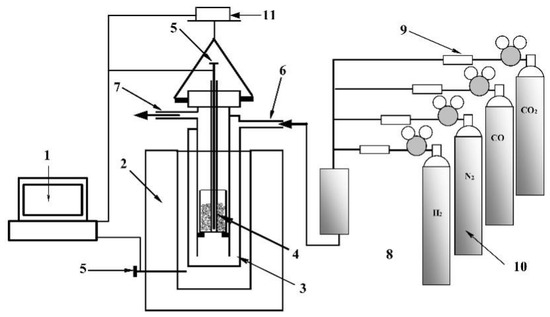
Figure 1.
Schematics of experimental apparatus for reduction experiments.
For the RDI tests, each sinter sample was reduced at 550 °C for 30 min with a 13.3 L/min reducing gas flow. During the temperature-rise period and cooling period, a 5 L/min flow of pure N2 was introduced into the reactor tube to avoid undesirable oxidation-reduction reactions for the sinter samples. The reducing gas consisted of 35% CO, 50% CO2 and 15% H2, simulating the gas composition in the middle-upper part of the COREX shaft furnace. After the reduction and cooling process, the sinter samples were removed from the reactor tube and charged into a tumbling drum (Φ130 mm × 200 mm) and rotated for 10 min at a speed of 30 rpm. After tumbling, the samples were sieved with 6.3 mm, 3.15 mm and 0.5 mm mesh to determine the particle size distribution. Then the RDI was calculated by the Equations (1)–(3) as follows:
where M is the mass of sinter samples after reduction, M1 and M2 are the masses of particles above 6.3 mm and 3.15 mm respectively after tumbling and M3 is the mass of particles below 0.5 mm.
In terms of RI tests, sinter samples were reduced at 820 °C for 180 min with a 13.3 L/min reducing gas, which contained 68% CO, 9% CO2 and 23% H2. Pure N2 at 5 L/min was introduced into the reactor tube during the temperature-rise period and cooling period. After the reduced samples were cooled to air temperature, they were removed and weighed. Then the RI was determined by the changes in the mass of samples before and after reduction, as shown in Equation (4).
where m1 is the mass of sinter before reduction; m2 is the mass of sinter after reduction; w1 and w2 are the FeO and total Fe contents of sinter, respectively.
In addition, optical microscopy (Leica DMI5000M, Leica Microsystems, Wetzlar, Germany) and scanning electron microscopy (SEM) with energy dispersive spectrometry (EDS) (PhenomPro, Phenom-World, Eindhoven, Netherlands) were employed to analyze the microstructure and mineral composition of sinter. The quantitative analysis of the mineralogy of sinter was performed using the image analysis software QWin of Leica optical microscope. The mineralogical analysis of sinter involved the quantification of phases’ areas of different morphologies by point counting [20].
3. Results and Discussion
3.1. Sintering Performance and Reduction Properties of Sinter with Different MgO Content
Under the condition that the sinter basicity was fixed at 1.8, sintering performance with different MgO content was investigated. Figure 2 shows the variations in productivity, sinter strength and solid fuel consumption as the MgO content of sinter increased from 1.36% to 3.1%. It indicates that the productivity increased gradually and then fell off and peaked at the MgO content of 2.1%. In the meantime, the sinter strength dropped off from 61.87% to 56.53% while the solid fuel consumption rose from 34.27 kg·t−1 to 38.84 kg·t−1.
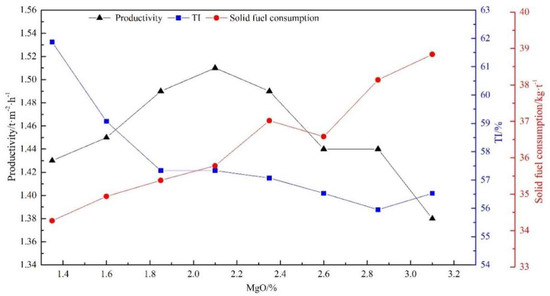
Figure 2.
Sintering indexes with different MgO content of sinter (TI-tumble strength).
With the premise of return fines balancing, the product sinter yield had little fluctuation, so the productivity was greatly influenced by the flame speed during the sintering process. To keep the basicity stable at 1.8 when the MgO content rose, the ratio of burnt lime, which acts as a binder, was reduced when dolomite increased, as shown in Table 2. This could affect the granulation of sinter mix, which is related to the permeability of sinter bed and flame speed during the sintering process [19]. This gives a reason why the productivity had a peak at a MgO content of approximately 2.1%. In the meantime, studies about the effect of MgO on liquidus in the CaO–SiO2–FexO phase diagram and on the high temperature properties of sinter indicated that increasing the MgO content restrained the generation of the liquid phase in the sintering process [21,22]. Consequently, the sinter strength fell off and solid fuel consumption increased with increasing MgO content of sinter.

Table 2.
The content of burnt lime and dolomite in each sintering blend.
In the reducing condition simulated COREX shaft furnace, the RI and RDI of sinter samples with various MgO content are shown in Figure 3. It suggests that as the MgO content increased from 1.36% to 3.10% the RI of sinter was variable in a certain interval of 86.01–88.94%, indicating that the increased MgO content of sinter would not significantly reduce the reducibility of sinter in the COREX shaft furnace. In terms of the reduction degradation, RDI+6.3 and RDI+3.15 rose from 24.52% and 61.43% to 47.19% and 76.41% respectively, while RDI−0.5 fell from 7.58% to 3.38%. In particular, the improvements of RDI+6.3 and RDI+3.15 of sinter were more noticeable after the MgO content exceeded 2.1%. The results are somewhat similar to those in some previous studies concerning the effect of MgO on the reduction properties of sinter in the BF reduction process [23,24]. Both studies showed that increasing MgO content exhibited an apparent inhibitory effect on the reduction degradation of sinter. Meanwhile, the reduction performance of sinter was also slightly decreased. However, for the reduction performance of sinter in the COREX shaft furnace, the adverse effect of increasing MgO content is less obvious, as this work presented.
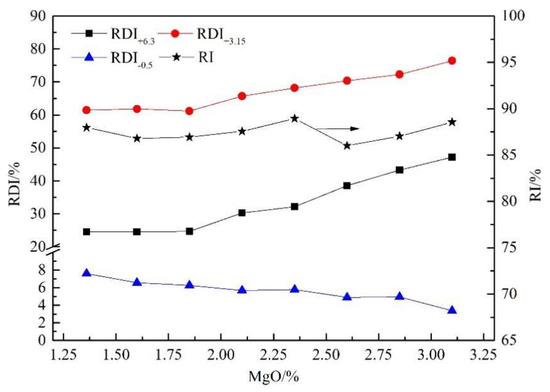
Figure 3.
Effect of MgO content on the RDI and RI of sinter in COREX shaft furnace.
In summary, increasing the MgO content promoted a better reduction degradation performance of sinter and had almost no adverse effect on its reducibility but led to a lower sinter strength and higher energy consumption at the same time. On the other hand, with a fixed sinter basicity of 1.8 even if the MgO content was increased to 3.1%, the reduction degradation performance of sinter could still not completely meet the requirements of RDI+6.3 ≥ 50% and RDI+3.15 ≥ 70%. Therefore, only increasing the MgO content of sinter to improve its low temperature reduction degradation performance is not sufficient for the preparation of sinter for the COREX process.
3.2. Effect of Sinter Basicity on the Sintering Performance and Reduction Properties of Sinter with Various MgO Content
Under conditions that the MgO content of sinter was set as 2.35% and 3.1%, sintering experiments with various sinter basicity were conducted, and the results are shown in Figure 4 and Figure 5 respectively. The results suggest that the changing rules of sintering performance were similar when the sinter basicity increased gradually even with different MgO content. As with 2.35% and 3.1% MgO, the sinter productivity increased from 1.38 t·m−2·h−1 and 1.24 t·m−2·h−1 to 1.49 t·m−2·h−1 and 1.43 t·m−2·h−1, increasing by 7.97% and 15.32% respectively. The tumble strength of sinters with different MgO content were both presented as concave lines when sinter basicity rose gradually, and the minimum values of the tumble index occurred in the interval of basicity from 1.2 to 1.6. The solid fuel consumption tended to decrease gradually as basicity increased for both MgO content, reducing by 1.43 kg/t and 4.54 kg/t, respectively, across all basicity ranges. Furthermore, the influence of basicity on solid fuel consumption was more obvious with higher MgO content of sinter. These experimental results are partially congruent with some previous research findings, especially for the sinter strength, even though they have different raw material conditions compared with this work [25,26]. For sinter production, the basicity range of 1.2–1.6 should be avoided regardless of MgO content
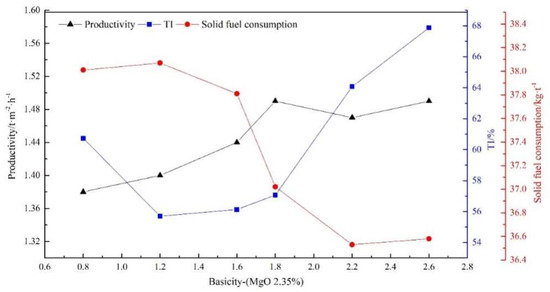
Figure 4.
Effect of basicity on sintering performance with 2.35% MgO content.

Figure 5.
Effect of basicity on sintering performance with 3.1% MgO content.
In the reducing condition simulated COREX shaft furnace, the effects of basicity on the RDI and RI of sinter samples with different MgO content were investigated and the results are shown in Figure 6. Regardless of MgO content, the influence of basicity on the RDI of sinter was similar to that on the tumble strength of sinter, both RDI+6.3 and RDI+3.15 of sinter presented a V-shaped curve, while RDI−0.5 presented an inverted V-shaped curve, as shown in Figure 6a–c respectively. For instance, when sinter contained 2.35% MgO, with the sinter basicity increased from 0.8 to 1.6, the RDI+6.3 and RDI+3.15 decreased rapidly from 50.29% and 75.81% to 28.48% and 62.95% respectively, and RDI−0.5 increased from 3.87% to 6.03%. When sinter basicity increased continuously to 2.6, the RDI+6.3 and RDI+3.15 gradually increased to 53.26% and 73.49% respectively, while RDI−0.5 decreased to 4.4%. In addition, the low-temperature reduction degradation performance of sinter is positively correlated with MgO content in the whole basicity range of experiments, which corresponds well to the results of Section 3.1. Besides, the improvement of RDI brought by increasing the MgO content of sinter seemed more obvious when the sinter basicity was higher. For the RI of sinter, in both kinds of sinter with different MgO content, their reduction performance rapidly increased when the sinter basicity rose. The RI of sinter increased from 76.58% and 76.75% to 94.18% and 92.18%, respectively, as the basicity increased from 0.8 to 2.6. As the sinter basicity reached 1.8, the RI of all sinter samples with different MgO content exceeded 85%, which means excellent reducibility under reducing conditions simulating the COREX shaft furnace.
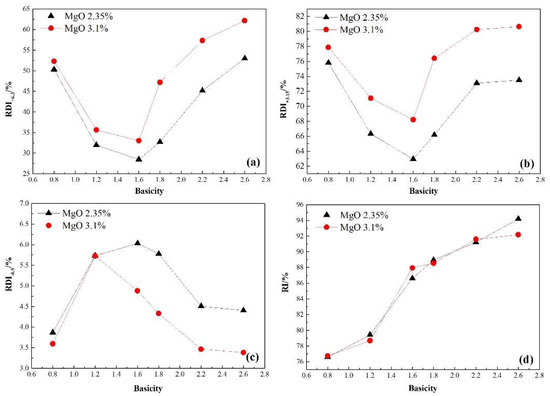
Figure 6.
Effect of basicity on the RDI and RI of sinter with different MgO content, (a)—RDI+6.3, (b)—RDI+3.15, (c)—RDI−0.5, (d)—RI.
According to the above experimental results, several alternative options for preparing sinter whose RDI+6.3 ≥ 50% and RDI+3.15 ≥ 70% through adjusting basicity and MgO content were proposed, including sinter with low basicity (0.8), sinter with basicity 2.6 and 2.35% MgO content, and sinter with basicity 2.2 and 3.10% MgO content. However, the sinter with low basicity (0.8) had a much lower reducibility than the other kinds of sinter, which might lead to a lower reduction performance of the composite burden in the COREX shaft furnace. Taking into account the influence of basicity and MgO content on the sintering production and reduction properties of sinter in COREX shaft furnace comprehensively, sinter with basicity above 2.2 and MgO content above 2.35% was proposed for industrial production.
3.3. Mineralogy of Sinter with Different Basicity and MgO Content
The quality and metallurgical performance of sinter are markedly relevant to its microstructure and mineralogical composition. Therefore, this work investigated the differences and changes in the mineralogy of sinter with various levels of MgO content and basicity. Figure 7 shows the microstructure of the product sinter samples that contained 1.36%, 2.35% and 3.10% MgO when the sinter basicity was fixed at 1.8. For sinter samples with different MgO content, their main mineral phases were all magnetite, hematite and silicoferrites of calcium and aluminum (SFCA) and glass phase, indicating that there is no obvious correlation between the mineral species and the MgO content of sinter, as well as microstructure. In addition, it is notable that most of the hematite phase in sinter samples was secondary hematite, which was deemed as an important factor that aggravates the reduction degradation of sinter [13,14,15].
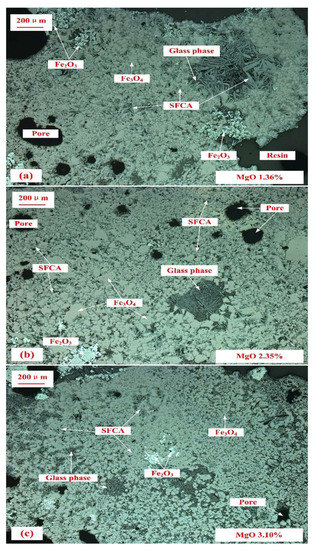
Figure 7.
Microstructure of sinter with different MgO content (basicity 1.8), (a) MgO 1.36%, (b) MgO 2.35%, (c) MgO 3.1%.
Figure 8 shows the microstructure of product sinter samples with a basicity of 0.8, basicity of 1.6 and basicity of 2.6 when all of them contained 2.35% MgO. It suggests that basicity had a significant effect on the mineralogy of sinter. The mineral phase in sinter of basicity 0.8 was mainly Fe3O4, Fe2O3 and glass phase, which was actually uncrystallized ferrous calcium silicate (olivine). The hematite and magnetite were cemented by the glass phase, forming a low-porosity microstructure. This compact structure is beneficial to the strength of sinter but could also lead to worse reduction performance because the diffusion of reducing gas becomes more difficult in the internal part of sinter. For sinter of basicity 1.6, the predominant minerals were still magnetite, hematite and glass phase. A small amount of blocky SFCA (plate alumosilicoferrite based on CF2) appearing with magnetite grains was observed in the sinter. The binding agent, which was mainly the glass phase, mostly appeared in a state of occupying the space between hematite and magnetite grains. Moreover, the porosity of sinter optically seemed higher than that of sinter with a basicity of 0.8. As the basicity increased to 2.6, the mineralogy of sinter became significantly different compared to the former two. It is characterized by a large number of sections that are made up of eutectic calcium ferrites and magnetite grains. As the main binding phase, SFCA (low-iron alumosilicoferrites based on CF and on CF2) presented acicular or columnar shapes and connected with other melt-precipitated phases. Magnetite appeared in the form of disintegrated aggregate formations and relicts among SFCA areas. Meanwhile, a small amount of glass phase was observed in the space between SFCA and magnetite.
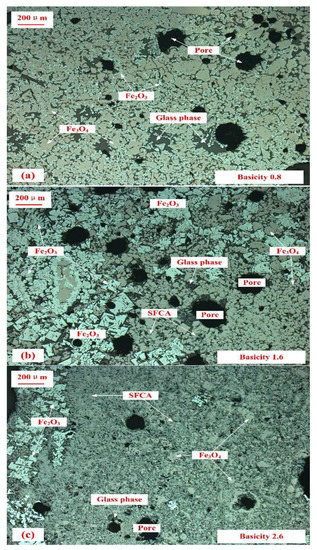
Figure 8.
Microstructure of sinter with different basicity (2.35% MgO), (a) basicity 0.8, (b) basicity 1.6, (c) basicity 2.6.
To quantitatively show the change in the mineralogy of sinter, the mineral composition was investigated, and the statistical mineral composition of sinter with different MgO content and basicity is shown in Table 3. It reveals that both the MgO content and the basicity of sinter have obvious influences on its mineral composition. When the sinter basicity was set to 1.8, as the MgO content of sinter rose from 1.36% to 3.10% and the amounts of hematite, glass phase and SFCA all decreased, while the amount of magnetite distinctly increased. In addition, the porosity of sinter also increased slightly. Under the condition that the MgO content was 2.35%, when the basicity of sinter increased from 0.8 to 2.6, the amounts of magnetite and glassy phase were apparently reduced while the amount of SFCA increased, as well as porosity. These results generally agree with the above optical analysis of the microstructure of sinter with various MgO content and basicity.

Table 3.
Mineral composition of sinter with different MgO content and basicity/area, %.
Aiming at the action mechanism of MgO on the mineralization of the sintering process, there are many studies showing that the Mg2+ derived from flux has an isomorphic replacement with Fe2+ from ferrous oxide and eventually forms (Fe, Mg)O·Fe2O3 existing in magnetite [19,27,28], which was also verified in the present work. An energy dispersive spectrometer (EDS) measurement was conducted for a sinter sample with 3.10% MgO and a basicity of 1.8, and the result is shown in Figure 9. It indicates that Mg was mainly distributed in the magnetite phase, a small amount of Mg was found in the glass phase and SFCA and no Mg appeared in the hematite, which confirms that most MgO formed a solid solution with magnetite. This reaction could make magnetite more stable and impede its oxidization to hematite. Accordingly, the formation of SFCA, which is a key bonding phase and is basically responsible for the strength of fluxed sinter, was affected. Consequently, the sinter strength reduced gradually with increasing MgO content. However, the decrease in hematite in sinter also brought a lower low-temperature reduction degree and then reduced the probable inner stress generated by the reduction of Fe2O3 to Fe3O4 during the reducing process. Under the comprehensive function, the reduction degradation of sinter was repressed to a certain extent with increasing MgO content, as shown in Figure 3.
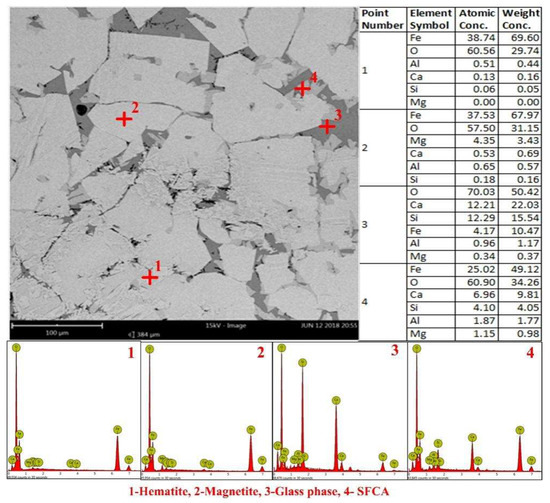
Figure 9.
Distribution of main elements in different minerals of sinter.
In comparison with the MgO content, the action mechanism of basicity on the mineralization of the sintering process was relatively clear. For sinter with low basicity (0.8) and high basicity (2.6), the main binding phases are glass and SFCA respectively as shown in Figure 7 and Table 2. These two kinds of adhesive phases could both make different minerals and particles of sinter present a rather closely cemented appearance. Thus, sinter with low basicity and high basicity generally possesses high strength. In terms of sinter with middle basicity (1.6), the microstructure clearly shows that different minerals appeared in spotty patterns. Most of the binding phases, including silicate glass and SFCA, existed independently and occupied the space between Fe2O3 and Fe3O4 grains, which had a harmful effect on the strength of sinter. As the microstructure of sinter could not resist the internal stress generated by solidification of the mineral phase from the ferrosilicate melt, the sinter strength was inevitably reduced. On the other hand, as the sinter basicity increased from 0.8 to 2.6, the amount of hematite deceased obviously, which means that the probable reduction of inner stress generated at low temperature would decrease. As a result, the low-temperature reduction degradation performance appeared in a V-shaped curve, and the minimum value occurred at a basicity of 1.6. Meanwhile, due to the high reducibility of SFCA, the RI of sinter increased gradually with increasing basicity [16,17].
3.4. Industrial Tests of Increasing the Sinter Proportion in the Composite Burden for the COREX Process
Based on laboratory research, industrial tests of a higher sinter proportion in the composite burden of the COREX process were conducted in Bayi Steel. Compared to the traditional sinter that has been used during the benchmark production period, the MgO content of sinter was raised to 2.4% from approximately 1.4%, and the basicity of sinter was raised to 2.4 from approximately 1.8% in the industrial test period. The average tumble strength of sinter increased by about 3 percentage points. Meanwhile, the burden structure was changed to 60% pellet and 40% sinter from 75% pellet and 25% sinter. After the production operation reached stability, the differential pressure of gas in the shaft furnace and metallization ratio of discharging materials during the benchmark production and testing periods were compared, as shown in Figure 10. It indicates that the differential pressure of gas in the shaft furnace increased slightly by 1.48 kPa, which means that the burden permeability in the shaft furnace was hardly affected. It is inferred that the low-temperature reduction degradation performance of the composite burden in the shaft furnace could still meet the requirements of RDI+6.3 ≥ 70% and RDI+3.15 ≥ 80%, although the sinter proportion in the composite burden was raised to 40% from 25%. On the other hand, due to the improvement of the reducibility of sinter, the metallization ratio of discharging materials of the shaft furnace was markedly increased by 13.44 percentage points.
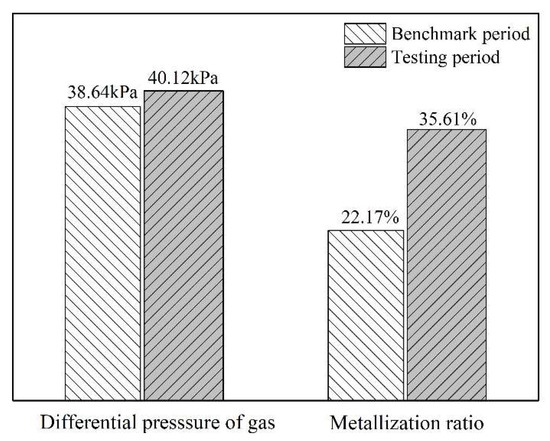
Figure 10.
Differential pressure of gas in the shaft furnace and metallization ratio of discharging materials in different periods (11 m in height of charge column).
Industrial production tests of higher sinter proportions lasted for more than 30 days, during which time the shaft furnace was kept in a stably running condition and did not develop signs of abnormal conditions, such as poor burden permeability, irregular furnace operation and hanging. The results demonstrated that the sinter proportion in the composite burden for the COREX shaft furnace could be increased after the low-temperature reduction degradation performance of sinter was improved, and increasing the MgO content and basicity of sinter was an effective measure. According to enterprise internal measurements, the material cost of molten iron in the COREX process was reduced more than 15 yuan/t further after the sinter proportion in the composite burden was raised to 40%.
4. Conclusions
The preparation of sinter for the COREX reduction process by varying the basicity and MgO content was investigated, and the following conclusions were drawn:
- (1)
- For sintering with a basicity of 1.8, increasing the MgO content from natural (1.36%) to 3.1% decreased the sinter strength by 5.44 percentage points and increased solid fuel consumption by 4.57 kg/t. In the meantime, the RDI+6.3 and RDI+3.15 of sinter were both greatly improved, while the RI changed slightly under conditions simulating the COREX shaft furnace. However, only increasing the MgO content of sinter could not completely meet the requirement of composite burden for the reduction degradation performance of sinter.
- (2)
- As the sinter basicity increased from 0.8 to 2.6 regardless of MgO content, the productivity increased gradually while the solid fuel consumption decreased, the sinter strength varied as a V-shaped curve, and the minimum value occurred at a basicity of approximately 1.6. Simultaneously, the RDI+6.3 and RDI+3.15 of sinter behaved nearly the same as the sinter strength, while the RI increased significantly under conditions simulating the COREX shaft furnace. Taking comprehensive consideration of sintering and reduction performance, the combination of basicity 2.2+ and MgO content 2.35%+ of sinter was recommended for preparing sinter for the COREX process.
- (3)
- Fewer SFCA and hematite were observed in the sinter with a higher MgO content, which were related to the decrease in sinter strength and reduction of inner stress respectively. The binding phase in sinter with low basicity (0.8) and high basicity (2.6) was glass and SFCA, respectively. They were associated with the relatively higher sinter strength. The changes in the mineralogy of sinter determined the variations in the RDI of sinter with different MgO content and basicity, by affecting the sinter strength and probable reduction of inner stress.
- (4)
- After increasing the MgO content and basicity of sinter to 2.4% and 2.4 respectively in industrial tests, the sinter proportion in the composite burden was further raised to 40%, and the COREX shaft furnace maintained stable running conditions.
Author Contributions
Conceptualization, D.Z. and J.P.; methodology, B.S.; investigation, B.S.; resources, D.Z.; data curation, J.P.; writing—original draft preparation, B.S.; writing—review and editing, B.S. and Z.W.; supervision, D.Z.; project administration, J.P.; funding acquisition, D.Z. All authors have read and agreed to the published version of the manuscript.
Funding
This research was funded by the Innovation-oriented Project for High-tech Industries of Hunan Province [No.2020GK4055].
Data Availability Statement
The data presented in this study are available on request from the corresponding author.
Conflicts of Interest
The authors declare no conflict of interest.
References
- Song, J.Y.; Jiang, Z.Y.; Cheng, B.; Xu, A.J. Comparison of energy consumption and CO2 emission for three steel production routes—integrated steel plant equipped with blast furnace, oxygen blast furnace or COREX. Metals 2019, 9, 364. [Google Scholar] [CrossRef]
- Kumar, P.P.; Gupta, D.; Naha, T.K.; Gupta, S.S. Factors affecting fuel rate in COREX process. Ironmak. Steelmak. 2013, 33, 293–298. [Google Scholar] [CrossRef]
- Qiu, Z.L.; Luo, Z.G.; Wang, F.; Nie, H.Q.; Chen, R.; Zou, Z.S. The effect of screw design on solid behaviors and the interaction between solid and screws in COREX shaft furnace. Steel Res. Int. 2017, 88, 1600259. [Google Scholar] [CrossRef]
- Eberle, A.; Siuka, D.; Bohm, C. New COREX C-3000 plant for Baosteel and status of the COREX technology. Stahl Eisen 2006, 126, 31. [Google Scholar]
- Zhu, R.L.; Zhu, J.M.; Song, W.G. Present operation situation and development prospect of Baosteel COREX-3000. Baosteel Technol. 2011, 6, 12–17. (In Chinese) [Google Scholar]
- Chen, R.P.; Tan, P. Analysis the production performance of Baosteel COREX-3000 to guide the COREX production of Bayi steel. Xinjiang Iron Steel 2014, 2, 19–21. (In Chinese) [Google Scholar]
- Tian, B.S.; Li, W.H. Production practice of blowing-in OY furnace of Bayi-steel. Xinjiang Iron Steel 2015, 4, 1–4. (In Chinese) [Google Scholar]
- Zou, Q.F.; Chen, R.L. Optimization of production process control of OY furnace of Bayi-steel. Ironmaking 2017, 36, 60–62. (In Chinese) [Google Scholar]
- Shi, B.J.; Zhu, D.Q.; Pan, J.; Xue, Y.X. Reduction behaviors of sinter made from magnetite concentrates in reducing process simulated COREX shaft furnace. In Proceedings of the 8th International Symposium on High-Temperature Metallurgical Processing, San Diego, CA, USA, 26 February–2 March 2017; Springer International Publishing AG: Cham, Switzerland, 2017. [Google Scholar] [CrossRef]
- Bai, M.H.; Han, S.F.; Zhang, W.Y.; Xu, K.; Long, H. Influence of bed conditions on gas flow in the COREX shaft furnace by DEM–CFD modelling. Ironmak. Steelmak. 2017, 44, 685–691. [Google Scholar] [CrossRef]
- Hou, Q.F.; Samman, M.; Li, J.; Yu, A.B. Modeling the gas-solid flow in the reduction shaft of COREX. ISIJ Int. 2014, 54, 1772–1780. [Google Scholar] [CrossRef]
- Shi, B.J.; Zhu, D.Q.; Pan, J.; Hu, B.; Wang, Z.C. Reducing process of sinter in COREX shaft furnace and influence of sinter proportion on reduction properties of composite burden. J. Cent. South Univ. 2021, 28, 690–698. [Google Scholar] [CrossRef]
- Asada, M.; Shima, M.; Omori, Y. Measurement of macro strain in the course of reduction of the skeletal hematite in sinter. Tetsu-To-Hagane 1987, 73, 1901–1908. [Google Scholar] [CrossRef][Green Version]
- Loo, C.E.; Bristow, N.J. Mechanism of low-temperature reduction degradation of iron ore sinters. Trans. Inst. Min. Metall. Sect. C 1994, 103, 126–135. [Google Scholar]
- Nakajima, R.; Sumigama, T.; Wakimoto, K.; Nagano, S.; Kawata, H.; Sakurai, M. Reduction degradation behavior of sinter in the blast furnace shaft(blast furnace phenomena). Tetsu-To-Hagane 1987, 73, 1964–1971. [Google Scholar] [CrossRef][Green Version]
- Umadevi, T.; Sah, R.; Mahapatra, P.C. Influence of sinter basicity (CaO/SiO2) on low and high alumina iron ore sinter quality. Miner. Process. Extr. Metall. 2014, 123, 75–85. [Google Scholar] [CrossRef]
- Tang, W.D.; Yang, S.T.; Zhang, L.H.; Huang, Z.; Yang, H.; Xue, X.X. Effects of basicity and temperature on mineralogy and reduction behaviors of high-chromium vanadium-titanium magnetite sinters. J. Cent. South Univ. 2019, 26, 132–145. [Google Scholar] [CrossRef]
- Murakami, T.; Kamiya, Y.; Kodaira, T.; Kasai, E. Reduction disintegration behavior of iron ore sinter under high H2 and H2O conditions. ISIJ Int. 2012, 52, 1447–1453. [Google Scholar] [CrossRef]
- Shi, B.J.; Zhu, D.Q.; Pan, J.; Liu, X.Q.; Li, S.W. Combined effect of MgO and basicity varied by different dolomite and burnt lime addition on sintering performance of magnetite concentrates. Ironmak. Steelmak. 2020, 47, 567–573. [Google Scholar] [CrossRef]
- Zhu, D.Q.; Chou, J.L.; Shi, B.J.; Pan, J. Influence of MgO on low temperature reduction and mineralogical changes of sinter in simulated COREX shaft furnace reducing conditions. Minerals 2019, 9, 272. [Google Scholar] [CrossRef]
- Hisao, K.; Tsutomu, O.; Mitsuru, K.; Matsumoto, A.; Hamano, T.; Tsukihashi, F. Effect of Al2O3 and MgO additions on liquidus for the CaO-SiO2-FeOx system at 1573K. ISIJ Int. 2005, 45, 506–512. [Google Scholar]
- Pei, Y.D.; Wu, S.L.; Zhao, Z.X.; An, G.; Su, B.; Pan, W. In-situ observation of influence of MgO on high temperature properties of sinter ore. Ironmak. Steelmak. 2014, 49, 14–19. (In Chinese) [Google Scholar]
- Jiang, X.; Wu, G.S.; Wei, G.; Li, X.G.; Shen, F.M. Effect of MgO on sintering process and metallurgical properties of sinter. Ironmak. Steelmak. 2006, 41, 1–5. (In Chinese) [Google Scholar]
- Guo, Y.F.; Guo, X.M. Effect of MgO on low temperature reduction process of hematite fines sinter. J. Iron Steel Res. 2017, 29, 697–703. (In Chinese) [Google Scholar] [CrossRef]
- Yang, S.T.; Zhou, M.; Jiang, T.; Xue, X.X. Study on Sintering Characteristics of Ultra-Poor Vanadium-Titanium Magnetite. Minerals 2021, 11, 515. [Google Scholar] [CrossRef]
- Bobylev, G.S.; Kovalenko, A.G.; Padalka, V.P.; Kochura, V.V.; Khaibulaev, A.S. Full-scale experimental test production of high-basicity sinter in the Enakievo metallurgical plant sinter shop. Metallurgist 2020, 64, 741–749. [Google Scholar] [CrossRef]
- Fan, X.H.; Li, W.Q.; Gan, M.; Chen, X.L.; Yuan, L.S.; Ji, Z.Y.; Yu, Z.Y.; Huang, X.X.; Su, D. Influence and mechanism of MgO on strength of high basicity sinter. J. Cent. South Univ. (Sci. Technol.) 2012, 43, 3325–3330. (In Chinese) [Google Scholar] [CrossRef]
- Yadav, U.S.; Pandey, B.D.; Das, B.K.; Jena, D.N. Influence of magnesia on sintering characteristics of iron ore. Ironmak. Steelmak. 2002, 29, 91–95. [Google Scholar] [CrossRef]
Publisher’s Note: MDPI stays neutral with regard to jurisdictional claims in published maps and institutional affiliations. |
© 2022 by the authors. Licensee MDPI, Basel, Switzerland. This article is an open access article distributed under the terms and conditions of the Creative Commons Attribution (CC BY) license (https://creativecommons.org/licenses/by/4.0/).